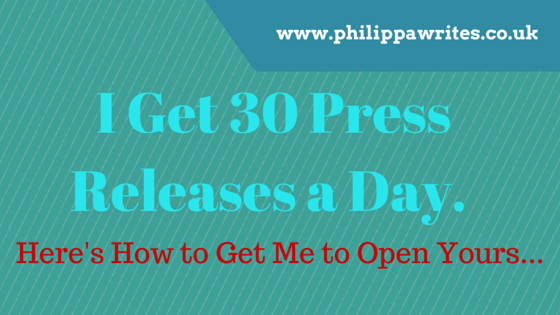As a writer, I do a combination of commercial content creation and journalism.
As part of the commercial work, I write press releases for businesses that want to gain some press attention. As a journalist, I get an inbox full of unsolicited, mostly terrible press releases from PR companies and brands.
I open maybe 10% of the press releases I receive, and I follow up on maybe 10% of those… so, if you are hoping to attract a journalist’s attention, what do you need to know to be part of that 1%?
Press release dos and don’ts: what this journalist needs you to know
- Do have a good subject line. This is probably the most important factor in whether a journo will hit ‘open’ or hit ‘archive’. It must intrigue the reader so they need to know more, and contain a useful indication of what the release is about.
- Don’t put the subject line in all caps. It makes it stand out, but for all the wrong reasons.
- Do tailor who you send the PR to. I write about SEO and social media, health and disability, and women’s issues. Fascinating as your news about garden implements or a new restaurant might be, it’s not relevant to what I write about and I won’t get it into the papers for you.
- Don’t share the content as an attachment. As you have seen, the chances of getting your email opened at all are pretty slim. If you’ve got that elusive open, don’t make us click on risky attachments to find out what you want us to know. Include the text within the body of the email.
- Do follow the format of a traditional press release. A good press release tells me what it’s about in the first sentence and then gradually expands on it as it goes on. Don’t make me read three paragraphs before I know what you’re promoting.
- Don’t go on and on and on. I got a press release from a famous self-help guy that totalled about 4,000 words. Much of the text was incomprehensible and it felt more like a poorly written, overly long blog post than a press release. Sum everything up in a couple of paragraphs, with links to more information at the end to provide extra background details or theory. Choose each word carefully and don’t go on any longer than you really need to.
- Do proofread the press release before sending it. Receiving a PR that’s peppered with errors looks unprofessional and mistakes will be caught by eagle-eyed journos who will not be impressed. I’ve seen many a discussion on Twitter after a handful of journalists received the same press release, with the same mistakes, at the same time. That’s most definitely the wrong kind of attention.
- Don’t send a press release for the sake of it. Don’t bore journalists by sending out releases when you’ve hired a new sales guy, had a staff day out or got a new Facebook Page; we won’t believe you have anything newsworthy, even when you do.
- Do back up your claims. If you’re the number one product for x, or the highest ranking seller for y, show me how I can verify that that is true. Many PRs are full of exaggerated information that we just can’t put into a newspaper without qualification.
- Don’t forget to include quotes from relevant members of staff within your organisation or experts outside of it. This makes our life a lot easier and gives us a good place to start.
- Do personalise your approach. Use my name. Definitely don’t use ‘Dear Sir’.
- Don’t use jargon without explaining it. You might know what your industry’s specific terms mean, but I may not. Expecting me to do homework just to understand your PR means it’s likely to fall between the cracks. I just don’t have time!
- Do reply to questions. It’s amazing how many companies take the time to send out press releases then ignore responses. I’m definitely not going to cover something if I can’t get a decent response to a simple query.
- Don’t be late. If you want a story covered on Tuesday, it’s unreasonable to send your media release that morning. Use embargoes to make it clear that you don’t want coverage until a particular date, giving journalists time to research and write stories about your news.

